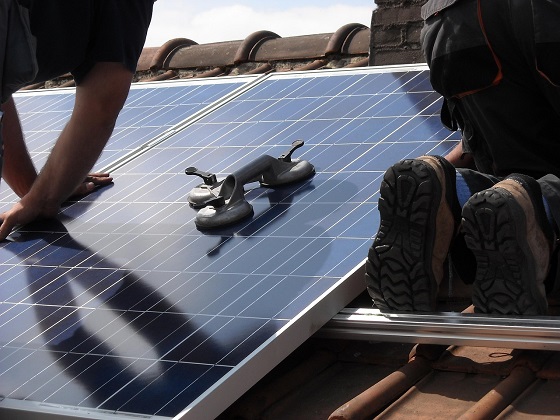South Africans are under mounting pressure as electricity prices rise, power stability declines, and the cost of living soars. Brights Hardware looks at how investing in solar can make a difference and provide security in uncertain times.

Eskom’s latest tariff hikes are already hitting hard, and further increases are expected. At the same time, load shedding remains an ongoing threat, with recent outages serving as a stark reminder of the grid’s fragility.
“With electricity prices rising unpredictably, homeowners and small business owners are looking for ways to protect themselves,” says Orlando Luis, CEO of Brights Hardware. “Solar and gas offer stability and long-term savings in an environment where energy costs are becoming harder to manage.”
Beyond cost savings, solar energy provides a crucial advantage – predictability. Unlike Eskom tariffs, which can surge unexpectedly, solar loan repayments remain fixed, allowing property owners to control their expenses with greater certainty.
Many South Africans hesitate due to the initial cost, but financing options make it far more accessible than most people realise. As Luis points out, “Every day, we talk to customers who are feeling the impact of rising electricity prices. Solar and gas products offer a way to take control of your energy costs, and in the long run, the savings are undeniable.”
A step-by-step guide to going solar
Investing in solar is one of the best ways to protect yourself from Eskom’s instability and lock in long-term energy savings. But to ensure you get the best results, doing your homework is key.
1. Optimise your electricity usage
Before installing solar, start by reducing your energy consumption. Small changes can make a significant difference in how much power you use – and how much solar capacity you need.
Switching to LED lighting is one of the easiest ways to cut down on electricity use. Energy-efficient options like the Flash 5-pack of 220 V 5 W LED downlighter globes (R99.95) or a standard ES 220 V 5 W LED globe (R21.95) use a fraction of the power of traditional bulbs while lasting much longer.
Smart planning also plays a role. Using a seven-day digital timer (R269) for high-energy appliances such as pool pumps can help avoid unnecessary power consumption during peak hours.
2. Determine your goals
Not all solar solutions are the same. The right setup depends on your needs:
If your priority is backup power during load shedding, start with a lithium-ion battery and a hybrid inverter. A DEYE 5 kW hybrid inverter (R24,599) paired with a Blue Nova 5.12 kWh lithium battery (R33,799) provides reliable storage and efficiency.
If you want to reduce monthly electricity bills, investing in solar panels is key. A Longi 555 W solar panel (R1,999) generates renewable power to lower dependence on Eskom.
For off-operating, a full system with solar panels, batteries, and a backup generator ensures total energy independence. A Ryobi 7,500 W electric key start petrol generator (R11,399) or a Red Rhino 5 kW dual-fuel petrol/LPG generator (R14,999) provides additional backup power when needed.
“Many people start small and build their system over time,” says Luis. “You can install solar panels now and add batteries later, or begin with a hybrid inverter and backup storage, then expand as your budget allows.”
3. Measure your power consumption
Understanding how much electricity you use helps determine the size of the solar system you need. Checking your electricity bill provides a baseline, but for real-time insights, an energy monitoring device like the Major Tech smart energy timer (R1,249) can track usage patterns and highlight potential savings.
4. Plan your budget and financing options
Solar is an investment, but flexible financing options make it accessible. “If you have an access bond, you can finance your solar installation at a lower interest rate, with monthly savings helping to offset costs,” suggests Luis. Brights Hardware also offers financing options through PayFlex, Pay Just Now, Mobicred, and Float, allowing customers to spread payments over time.
5. Choose the right components
A well-designed system ensures long-term reliability. Lithium-ion batteries have a longer lifespan than lead-acid alternatives, while hybrid inverters provide the flexibility to add battery storage later. Investing in ISO-certified solar panels with solid manufacturer warranties guarantees efficiency and durability.
“Working with reputable suppliers ensures your system is reliable and upgradable,” adds Luis.
6. Get professional installation and compliance
To maximise performance and avoid costly issues, solar installations should be handled by registered professionals. Your system must be:
- Installed by a certified professional (Pr Eng with the Engineering Council of South Africa).
- Signed off and compliant with municipal regulations.
- Registered with your local authority to meet legal requirements.
“Avoid fly-by-night installers,” warns Luis. “Check credentials, track records, and ensure they offer strong warranties.”
7. Insure your solar system
Once installed, solar systems should be included in home and business insurance policies. Homeowners should:
- Notify insurers to ensure coverage against storms, theft, or damage.
- Check for additional requirements, such as lightning protection.
- Use certified equipment to avoid issues with claims.
“By following these steps, your investment in solar is protected, optimised, and future-proof,” says Luis.
Secure your energy future today
With unpredictable electricity costs, ongoing load shedding, and rising living expenses, there’s never been a better time to invest in solar and gas solutions, according to Brights Hardware.
“If you need advice, the team at Brights is always here to help,” says Luis.